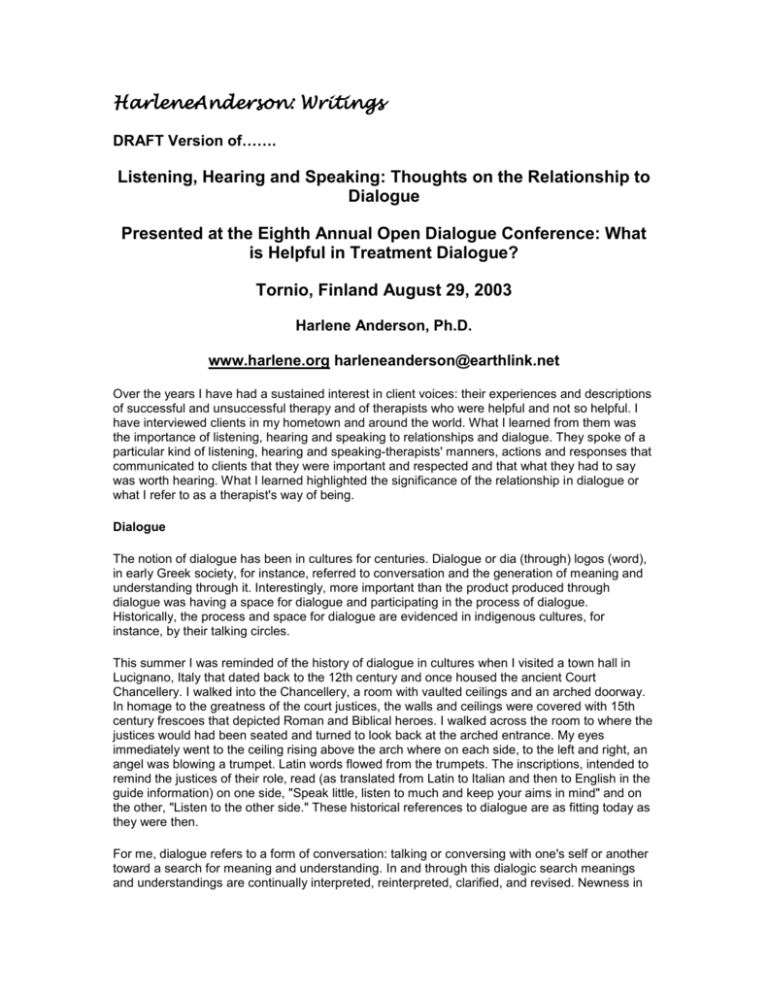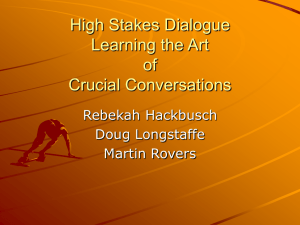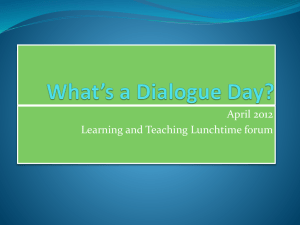Listening, Hearing and Speaking
advertisement

HarleneAnderson: Writings DRAFT Version of……. Listening, Hearing and Speaking: Thoughts on the Relationship to Dialogue Presented at the Eighth Annual Open Dialogue Conference: What is Helpful in Treatment Dialogue? Tornio, Finland August 29, 2003 Harlene Anderson, Ph.D. www.harlene.org harleneanderson@earthlink.net Over the years I have had a sustained interest in client voices: their experiences and descriptions of successful and unsuccessful therapy and of therapists who were helpful and not so helpful. I have interviewed clients in my hometown and around the world. What I learned from them was the importance of listening, hearing and speaking to relationships and dialogue. They spoke of a particular kind of listening, hearing and speaking-therapists' manners, actions and responses that communicated to clients that they were important and respected and that what they had to say was worth hearing. What I learned highlighted the significance of the relationship in dialogue or what I refer to as a therapist's way of being. Dialogue The notion of dialogue has been in cultures for centuries. Dialogue or dia (through) logos (word), in early Greek society, for instance, referred to conversation and the generation of meaning and understanding through it. Interestingly, more important than the product produced through dialogue was having a space for dialogue and participating in the process of dialogue. Historically, the process and space for dialogue are evidenced in indigenous cultures, for instance, by their talking circles. This summer I was reminded of the history of dialogue in cultures when I visited a town hall in Lucignano, Italy that dated back to the 12th century and once housed the ancient Court Chancellery. I walked into the Chancellery, a room with vaulted ceilings and an arched doorway. In homage to the greatness of the court justices, the walls and ceilings were covered with 15th century frescoes that depicted Roman and Biblical heroes. I walked across the room to where the justices would had been seated and turned to look back at the arched entrance. My eyes immediately went to the ceiling rising above the arch where on each side, to the left and right, an angel was blowing a trumpet. Latin words flowed from the trumpets. The inscriptions, intended to remind the justices of their role, read (as translated from Latin to Italian and then to English in the guide information) on one side, "Speak little, listen to much and keep your aims in mind" and on the other, "Listen to the other side." These historical references to dialogue are as fitting today as they were then. For me, dialogue refers to a form of conversation: talking or conversing with one's self or another toward a search for meaning and understanding. In and through this dialogic search meanings and understandings are continually interpreted, reinterpreted, clarified, and revised. Newness in meaning and understanding emerges, and thus, possibilities are generated for thought, feeling, emotion, action, and so forth. In other words, transformation is inherent in dialogue. True dialogue cannot be other than generative. Dialogue involves having space for people to connect and talk with each other. It involves a process in which participants engage with each other in shared or mutual inquiry: jointly examining, thinking, questioning and reflecting. In and through dialogue meaning and understandings are continually interpreted, reinterpreted, clarified, revised, and expanded. These characteristics distinguish dialogue as a dynamic generative joint activity and as different from other language activities such as discussion, debate, or chit chat. Dialogue is a relational and collaborative activity. Although dialogue is, of course, influenced by the multiple larger contexts and discourses in which it takes, of prime importance, however, is the relationship between the dialogical participants or what I refer to as the conversational partners. Wittgenstein talked of relationship and conversation going hand-in-hand: the kinds of conversations that we have with each other inform and form the kinds of relationships we have with each other and vice versa. Dialogue invites and requires of its participants a sense of mutuality, including genuine respect and sincere interest regarding the other. While at the same time, dialogue invites a sense of belonging and ownership. Dialogue, by its very nature, involves not-knowing and uncertainty. Sincere interest in another necessitates not-knowing the other and their situation ahead of time, whether the knowing is in the form of previous experience, theoretical knowledge, or familiarity. Knowing can preclude being inquisitive and learning about the uniqueness of the other. Because perspectives change and dialogue is transforming, it is impossible to predict how a story, for instance, will be told or the twists and turns it may take. Not-knowing refers to having a critical and tentative attitude about what you know or think you know (i. e. theory, facts, truths, beliefs, and assumptions) and offering it with that attitude. It also refers to the intent with which knowledge is introduced. To invite and facilitate dialogue, it is best offered with the intent that it is food for thought and dialogue rather than with an objective such as instructive interaction. Maintaining a not-knowing position and tolerating uncertainty are critical for the freedom of expression necessary and the opportunity for the natural "accidental" paths a dialogue can take. Also, not-knowing and uncertainty are important to inner or self-dialogue. And Listening, Hearing and Speaking Dialogue involves the reflexive, intertwined process of listening, hearing and speaking. Listening, hearing and speaking are intricately woven and each is critical to the other. They are not discrete step-ordered processes, nor are they techniques. What do these words refer to? In my interviews with clients, I often heard words such as, "She listened to me;" "He heard exactly what I said" and "All I really wanted was for someone to hear me." As I have written elsewhere, "Clients say they want to be listened to and heard. In the majority of my conversation with clients about their experience of therapy and whether it was helpful, the most common factor in unsuccessful therapies was not being listened to or heard. [Historically, l]istening is a taken-forgranted aspect of psychotherapy . . . . [Historically, t]he primary role of listening in psychotherapy, second only to observation, has been attaining a form of knowing, gaining clinical information. Listening for the most part has been a passive position or process. The active part, so to speak, occurs in a listener's head as what is heard is silently sorted out and made sense of. The belief has been that if a therapist could be a good listener-an empathetic listener, and attentive listener . . . such listening would lead to uncovering and accessing the feelings, thoughts, and meanings that were beyond or below . . . the client's actual words. This knowing through a special king of listening with a therapist's ear guides interventions. It is almost as if the talking cure and healing listening are separate step-ordered processes. In contrast, I think of listening and hearing as interrelated, active, mutual processes. I define listening as attending to, interacting with, responding to, and trying to learn about a client's story and its perceived importance." (Anderson, 1997, p. 152) In my experience, listening is always being in a process of trying to understand what the other person is saying. We try to understand by participating in and responding to what we think the other has said. Participating and responding involve being genuinely curious, asking questions to learn more about what is said (not what you think you should have been said) and checking-out to learn if what you think you heard is what the other person hoped you heard. I make a distinction between responses such as questions to participate in the storytelling that in turn help, for instance, to clarify, expand and understand and responses-such as questions-that seek details and facts to determine things such as diagnoses and interventions or seek to guide the conversation in a particular direction. As Tom Andersen mentioned earlier, responding is critical to inviting and encouraging both relationship and dialogue. And as Jaakko Seikkula said earlier, nothing is more terrible than a lack of response. A lack of response is a communication and clients have often reported feeling dismissed by a lack of response. I am reminded of the remarks of a colleague as she told about a colleague who took a position that she disagreed with and did not value. She said, earnestly, but a little smugly, "I was a good listener, I didn't say anything. I just listened and waited for him to continue." Though I do not know how the other person in this situation received my colleague's response, I refer to it to emphasize that a seemingly non-response is a response. It is important, therefore, to keep in mind what kind of responses facilitate and what kind hinder dialogue. A good listener responds, as John Shotter suggests, into the conversation. Also, in my experience, you learn more about the other person and their situation-and especially what they want you to know about them when you listen as if you are listening to a story. When you listen to a story you attend to the whole of the story; you do not listen for details and facts. You develop a sense of the story and a memory for the story. (I keep in mind that memory is a constructed reality.) Interestingly, surprisingly and paradoxically, when you let go of focusing on details and facts you develop a better memory for them as well. And, I would stretch to say that it becomes very difficult to take note of details and facts when you are engrossed in a story. As well, it is difficult to pay attention when you write notes while another is telling their story. I am reminded of the Pulitzer Prize winner Jhumpa Lahira whom I heard read from her new novel, The Namesake. I was captivated, as the rest of the audience seemed to be, by her reading, by her telling the story, about the protagonist Gogol's name. I eagerly hung on every word, picturing the characters and their actions. When she was finished I was anxious to hear the rest of the story: I did not know it. I still remember so many things about the little boy and the events and people in his life: words and phrases as well as facts and details, remained with me even though I was not collecting them while she was reading. Thinking of the whole of the story reminds me of the words of a man that I interviewed in Sweden who had a diagnosis of paranoid schizophrenia and who had treated by several psychiatrists and psychologists over five years. He told of those who asked questions to "gather details and facts" and those who asked questions to hear "the story they assumed they already knew." He said they never heard his story, never knew him. And with intense emotion he said that was "sad" and "painful." Not-knowing helps a listener attend to the whole of a story. It requires avoiding being seduced by parts of a story as important and not others and avoiding being spellbound by assumptions, myths and generalizations that a story might invite. In my experience, when you imagine a story metaphor you become engaged in the story and with the storyteller. Stories are mysterious; they are strange in the sense of unfamiliar and surprising. A mysterious situation and person invite wonderment and curiosity whereas a problem and problem owner invite solving and repairing. As I have written elsewhere, "The storytelling process, even though it involves both a teller and a listener, is far more complex than one person's telling a story and another person's listening. It involves hearing, which Levin (1992) defines as "a process involving a negotiating of understands" (p. 48), "an interactive struggle for shared meaning that occurs when two people (or more) attempt t come to a mutual understanding of something" (p. 50). Listening and hearing g hand-in-hand and cannot be separated. In my experience, negotiation of understanding that involves dialogue (one part of which is listening) is done in a distinct way that includes special therapist attitudes and actions that I call responsive-active listening-hearing. Responsive-active listening-hearing invites clients to tell us what it is like for them, what are their inner concerns. Shotter (1995b) suggested of this kind of listening and responding that we do not act out of an inner plan, we act responsively "into" a situation, doing what 'it' calls for" (p. 62). Each client has an ideological base (including preconceptions prejudices, experiences, and anticipations) that is unique and that influences the construction of his or her view of the problem and the story about it. To help a story be sharable a therapist must plunge into a client's world and show an interest in that client's view of the problem, its cause, its location, and its solution. Equally important, a therapist should learn a client's expectations of therapy and therapist. This kind of listening and hearing requires that a therapist enter the therapy domain with a genuine posture an manner characterized by an openness to another person's ideological base-his or her reality, beliefs, and experience's This listening posture and manner involve showing respect for, having humility toward, and believing that what a client has to say is worth hearing. It involve attending considerately, showing that we value a client's knowledge about his or her pain, misery, or dilemma. And, it entails indicating that we want to know more bout what a client has just said or may not yet have said-best accomplished by actively interacting with and responding to what a clients says by asking questions making comments, extending ideas, wonders, and sharing private thoughts aloud. Being interested in this way helps a therapist o clarity and prevent misunderstanding of the said and learn more about [and participate in the creation of] the unsaid…Such comments and questions that seek not to misunderstand must be offered in a tentative, curious manner that conveys genuine interest in getting it right. Responsive-active listening-hearing does not mean just sitting back and doing nothing. It does not mean that a therapist cannot see anything, offer an idea, or express an opinion. Nor does it mean that it is just a technique. Responsive-active listening-hearing is a natural therapist manner and attitude that communicates and demonstrates sincere interest, respect, and curiosity. The therapist gives as much room and time for a client's story as necessary, and, yes, at times, without interrupting. That is, it does not bother me nor do I draw an inference if a client chooses to talk for a long time." (Anderson, 1997, p. 152-154) Guidelines for Inviting Dialogue Listening, hearing, and speaking, as I have talked about them here, and in the case of therapy, consultation, or education are expressions of a way of being-a way of being that invites a metaphorical space which like for the ancient Greeks is a gathering place for the relational process of dialogue. But, how can you assume a way of being that invites dialogue? How can you invite another person to talk with you? In my experience, it involves authentically living what most of us desire for ourselves: that we are believed and trusted as a worthwhile human being no matter what our life circumstances might be; that others accept us no matter how nonsensical our words and actions may seem; and that we have a safe and ample opportunity for full expressio: Listen, hear, and speak respectively: Respect is a relational activity; it is not an individual internal characteristic. Respect is having and showing regard and consideration for the worthiness of the other. It is communicated by attitude, tone, posture, gestures, eyes, words, and surroundings. Listen, hear, and speak as a learner: Be genuinely curious about the other and sincerely believe that you can learn something from them. Listen and respond with sincere interest in what the other person is talking about-their experiences, their words, their feelings and so forth. Listen, hear, and speak to understand: Do not understand too quickly. Understanding is never-ending. Be tentative with what you think you know. Knowing interferes with dialogue: it can preclude learning about the other, being inspired by them, and the spontaneity intrinsic to genuine dialogue. Knowing also risks maintaining or increasing power differences Listen, hear, and speak with care: Pauses are important.Pause before you speak: Give the other person time to finish. And give yourself a moment to think about what you are going to say and how you will say it. Listen, hear, and speak in a self-reflective manner. Self-reflection Do not minimize the complexity of a dialogue by reducing it or its process to techniques. Listening, hearing and speaking are not techniques. They are relational activities and processes. Dialogue operates along a continuum: Sometimes we are less in a dialogical process and sometimes we are more so. I do not, for instance, look for or think in punctuations such as dialogical moments-significant, memorable, or critical moments. The whole or overall relationship and conversation is what counts and makes a difference. The encouragement and possibility for transforming and newness are inherent in these kinds of relationships and conversations. And to paraphrase Wittgenstein, dialogue allows each of us to find ways to go on from here. So, perhaps this is what is helpful in dialogue: We find ways to go on. Or, at least we have a sense or a hope that it is possible and that we will be able to go on.









